
RENÉ CHARTRAND, ILLUSTRATED BY RON VOLSTAD
CANADIAN FORCES IN WORLD WAR II
The 13th Inf Bde wore Canadian BD, the leather buckle-flap boots also later worn by the 3rd Inf Div in NW Europe, carried the light service respirator, and were armed with the Lee- Enfield No.4 rifle. Just about everything else was American, which made good logistical sense for a brigade attached to a large US force, and minimised the risk of being taken for enemy troops. The equipment set was based on the US 1923 cartridge belt; the men had American framed rucksacks, Arctic sleeping bags, and overcoat/parkas. A surviving parka-style coat made by Reed Products of Philadelphia in September 1942, worn by Pte. Ludger Saint-Laurent of the Régiment de Hull on Kiska in 1943, is of a light tan colour, reversible with a pile liner; it has a drawstring hood, a tightening tape in a waist 'tunnel', buttoned cuff tabs, a deep front fly, and two patch skirt pockets with flaps. The US M1 helmet was dressed with the Canadian camouflage net in two hues of khaki. Canadian officers of the brigade wore US rank badges on their berets, left of the regimental badge, and on the left collar of their blouse, as well as their Canadian rank badges on the shoulder straps. Note the yellow-on-blue title 'LE REGT DE HULL7CANADA' above the Bowie knife patch of the Kiska force.
B3: Sergeant, Calgary Regiment (14th Armoured Regiment), 1st Army Tank Brigade; Dieppe, 19 August 1942
The men of this Churchill tank regiment taking part in the disastrous Dieppe raid wore BD and WE 37 accoutrements. A number of tanks were disembarked, but their traction was hampered by the slippery shingle beach and they were all knocked out, mostly close to the waterline. Our figure is based on a tank crew sergeant seen there, desperately fighting with revolver in hand. His open blouse reveals a surprisingly modern touch - a sweatshirt with the regimental badge printed on; a German photo of a prisoner of the Fusiliers Mont-Royal shows that at least one other unit followed suit. The regimental badge is worn more conventionally pinned to his black armoured troops' beret The white tank right sleeve badge of the British Royal Tank Regt is visible in some photos of the Calgaries - it is not worn here, but note the regimental left shoulder lanyard. Their non-regulation UK-made shoulder title, with 'CANADA/THE CALGARY REGIMENT' in dark blue on lighter blue, seems to have been the only regimental title worn by units at Dieppe. At this date the 2nd Inf Div wore the white-on-khaki 'CANADA' title (of both straight and arc patterns), above their royal blue rectangular divisional patch with an added World War I scheme of 'battle badges'. The 4th, 5th and 6th Inf Bdes were identified by the colours green, red and dark blue respectively. The senior battalions had a coloured disc above the blue patch (Royal Regiment of Canada/ Black Watch/ Fusiliers Mont-Royal); the intermediate battalions, a half-disc butted down against it (Royal Hamilton LI/ Régt de Maisonneuve (absent)/ Cameron Highlanders); and the junior battalions, a shallow triangle (Essex Scottish/ Calgary Highlanders/ South Saskatchewan Regt).
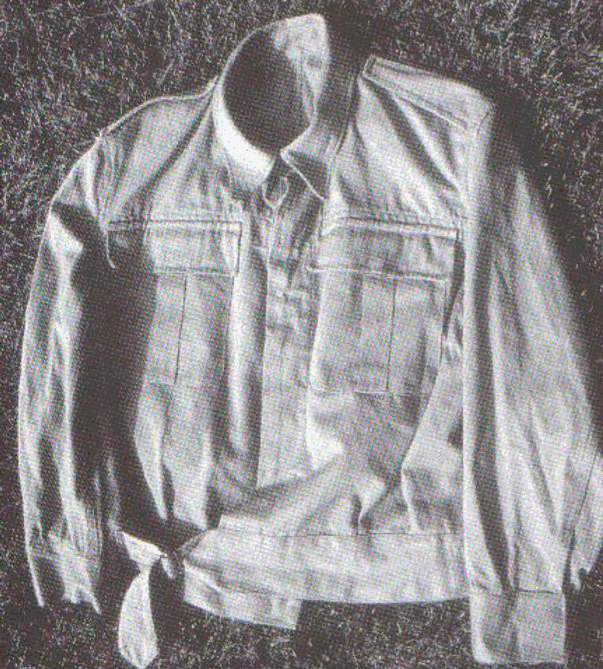
Light khaki denim Canadian BD blouse, this example made in April 1940. This summer version of Battledress, cut like the woollen blouse, was issued only in Canada and not overseas. (Ed Storey Collection)
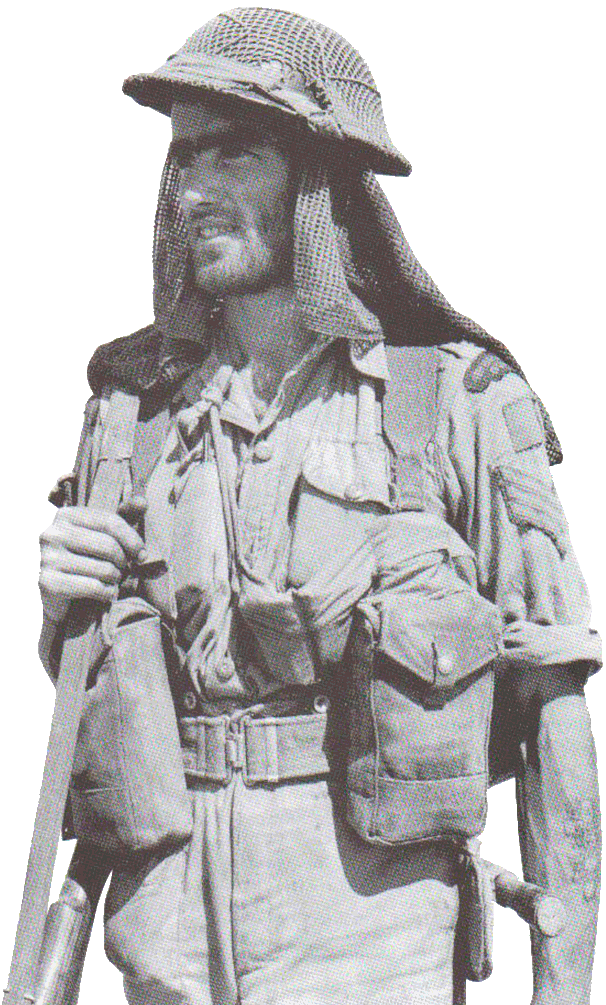
Sgt. H.E.Cooper, 48th Highlanders of Canada, in Sicily on 11 August 1943. This excellent illustration of a 1st Inf Div soldier wearing Canadian KD tropical bush shirt and slacks was widely distributed in the press, but Cooper's superiors were annoyed that he had been photographed unshaven... Note the regimental shoulder title, the red rectangular divisional patch and the sergeant's rank badge all rather roughly sewn to the upper sleeve; and the large khaki plastic removable buttons. (National Archives of Canada, PA130215)
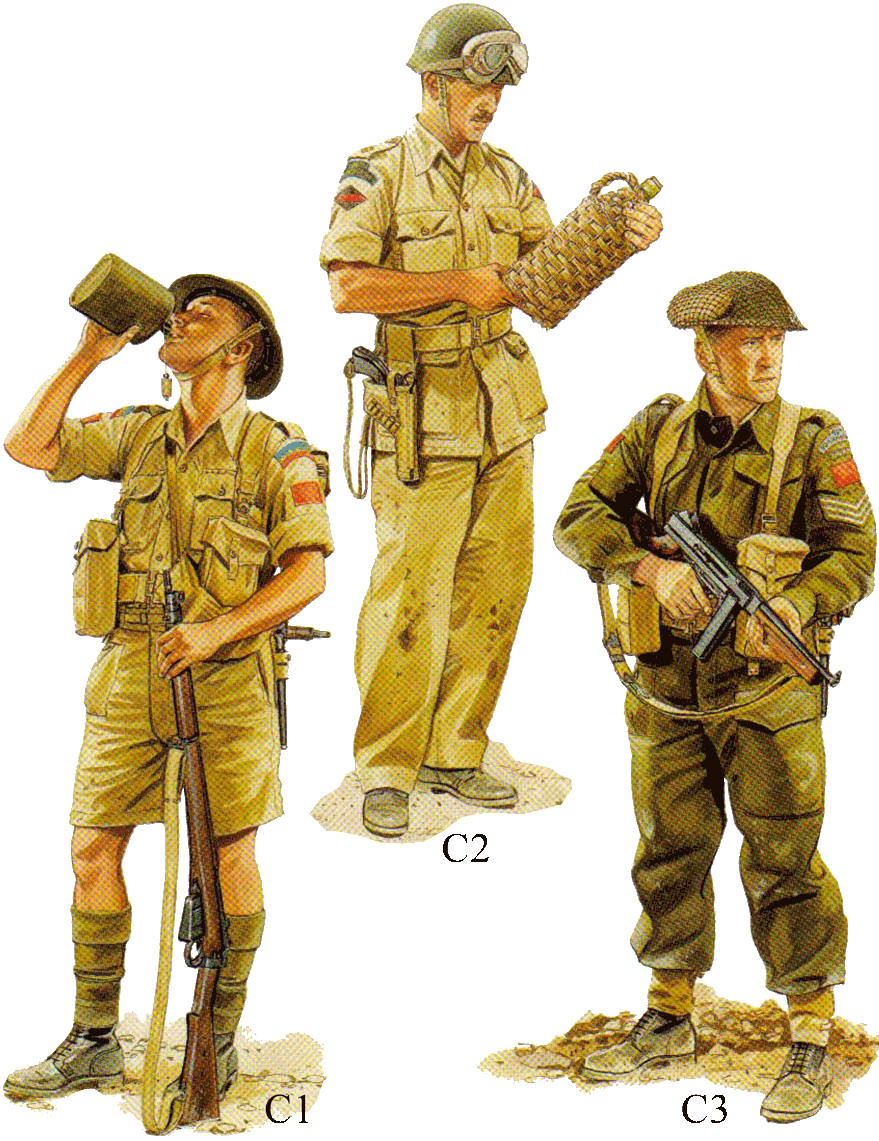
C1: Private, Royal 22e Régiment, 1st Infantry Division; Sicily, July 1943
This figure shows the typical dress - khaki drill shirt tucked into shorts, short puttees and hose tops - worn by the 1st Inf Div in Sicily and southern Italy in the summer of 1943. This famous French-Canadian Regular regiment (always known as the 'Van-doos', after the phonetic pronunciation of the French '22', vingt-deux) wore a large shoulder arc in blue over yellow over red with the full regimental title in black on the yellow stripe. The white-on-khaki 'CANADA' title was sometimes worn between this and the red divisional patch. The WE 37 accoutrements and No.4 rifle were standard issue. (L.Lamontagne, Histoire du Royal 22e Régiment, Quebec, 1964)
C2: 2nd Lieutenant, Ontario Regiment (11th Armoured Regiment), 1st Armoured Brigade; Italy, summer 1944
The old 1st Army Tank Bde was redesignated 1st Armd Bde In August 1943, but its component units were unchanged - the 11th (Ontario), 12th (Three Rivers) and 14th (Calgary) Armoured Regiments, all now equipped with Sherman tanks. The brigade fought in the bitter battle for Ortona at Christmas 1943, and the following year with XIII (British) Corps of US 5th Army in the advance on Florence. This troop commander wears his single buff-on-cavalry-yellow rank 'pip' on his shoulder strap slides, and the brigade's diamond-shaped black and red patch on the shoulders of his Canadian-made KD bush jacket, below a combined national/regimental title. The British Royal Armoured Corps steel helmet is worn with M1938 'Resistol' goggles. Equipment is limited to the WE 37 belt with M1942 (short strap) RAC holster for a 38in revolver.
C3: Sergeant, Loyal Edmonton Regiment, 1st Infantry Division; Italy, winter 1943-44
As the Canadians moved up into the wretchedly cold and wet Appenine Mountains in November 1943. BD and greatcoats were routinely worn but specialised winter clothing was slow to arrive. (Army blankets were turned into 'short coats, fetchingly tailored by Castropignano civilian artisans', according to Farley Mowat of the Hastings & Prince Edward Regiment.) The field dressing is tucked under the netting of the Mk II helmet; like most British and Commonwealth infantry junior leaders on the Italian front this sergeant is armed with a Thompson sub-machine gun, here the M1A1 model. Later examples of the 'CANADA' title were seen in buff rather than white lettering.
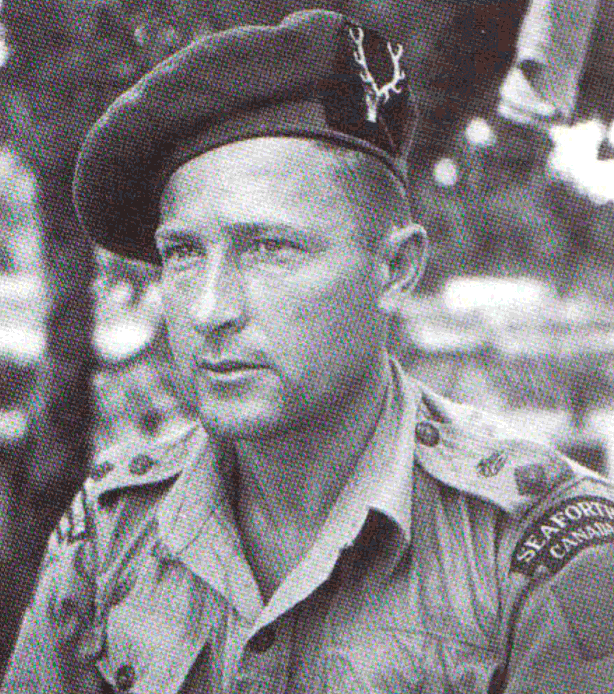
Lt.Col. B.M.Hoffmeister, Seaforth Highlanders of Canada, 1st Inf Div, Italy 1943. He wears the khaki wool Balmoral tam-o'shanter bonnet with the regimental cap badge on a backing of Mackenzie tartan, and the KD bush shirt with his white-on-black regimental/national title above the red divisional patch. One of the Army's brightest officers, Hoffmeister quickly rose to command 5th Armd Div in 1944, and was reorganising the 6th Inf Div when VJ-Day came in 1945. He then left the Army, went into business, and became president of MacMillan-Bloedell, one of Canada's largest companies. (T.Rowe, National Archives of Canada, PA132779)
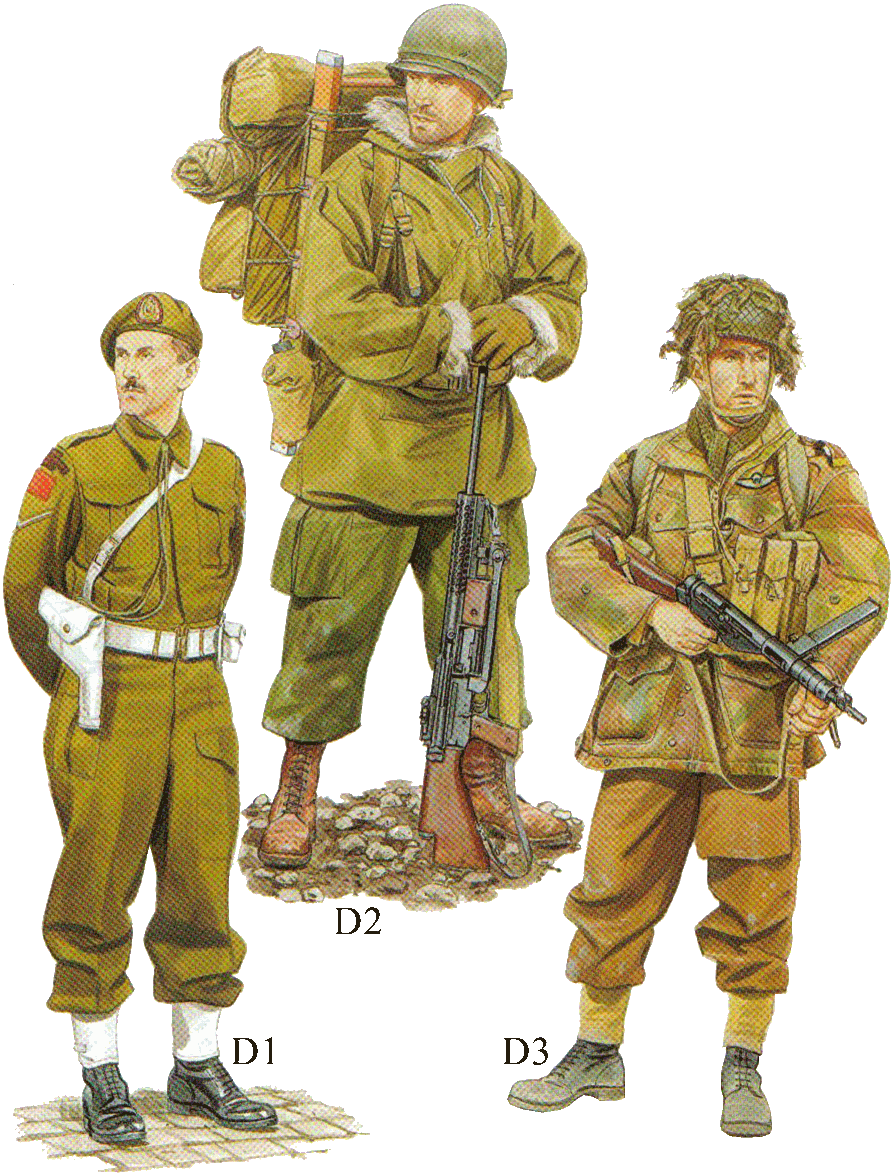
D1: Private, First Special Service Force; Anzio, Italy, 1944
This mixed US/Canadian commando-type unit was originally intended for an operation in occupied Norway. Raised in 1942 and trained in parachute and alpine warfare, it took part in the Kiska expedition in 1943, but proved its real worth as an outstanding infantry regiment in Italy. By the Anzio landings it was completely equipped with US uniforms, accoutrements, weapons and kit. Our figure has the US M1 helmet, a reversible first-pattern parka, mountain trousers, paratrooper boots and a 'Yukon7 pack. His weapon is the M1941 Johnson LMG, used in Europe only by the FSSF. (Burhans, Robert D., The First Special Service Force, Washington: Infantry Journal, 1947)
D2: Lance-Corporal, Royal Canadian Mounted Police, 1st Provost Company; Italy, 1943-45
Members of Canada's famous police force were organised into provost detachments serving with Army divisions in Europe. They wore Army BD with red-on-blue 'ROYAL/CANADIAN MOUNTED/POLICE' shoulder titles, and the RCMP cap badge on the FS cap and later the beret, sometimes on a red backing. On duty their WE 37 pistol equipment was whitened. Normal Army rank badges and formation signs were worn on the sleeves.
D3: Private, 1st Canadian Parachute Battalion; NW Europe, 1944-45
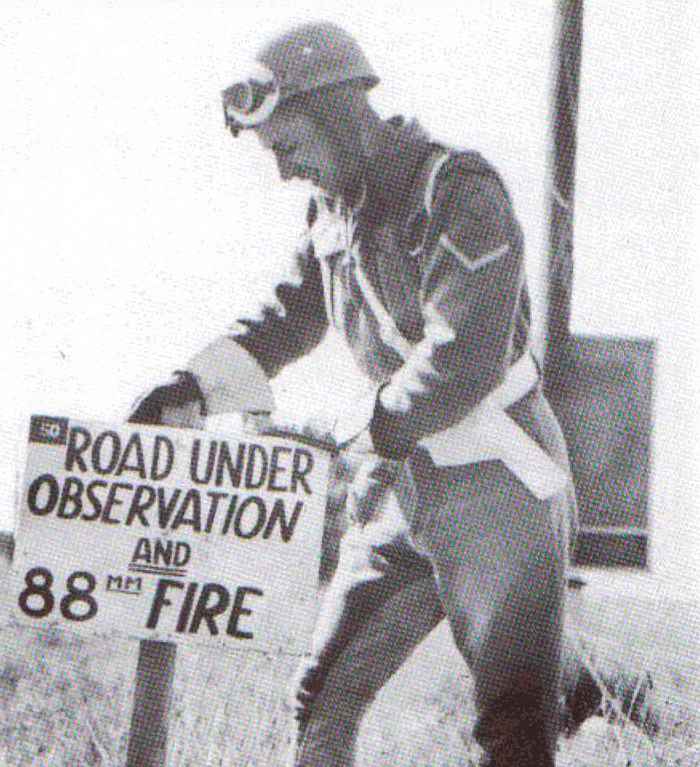
The Canadian paratroopers who jumped in Normandy and later on the Rhine were dressed and equipped exactly like their British comrades of 6th Airborne Division. This soldier has the third pattern jump helmet, camouflage netting face veil, second pattern Denison smock, and parachutist's BD trousers with an extra rear pocket, knife pocket in the seam, and enlarged 'bellows' left thigh pocket lined with thin leather. The WE 37 accoutrements include a 'bandolier' of seven Sten magazine pouches; he also carries a six-foot toggle rope for obstacle climbing. Only the Canadian parachute wings identify his nationality; out of the line he would also display the unit's distinctive badge on his maroon beret. The gold-yellow band on the shoulder straps also identified the unit within 3rd Abn Bde of 6th Airborne Division.
L/Cpl. P.Chimilar, a motorcyclist of the Canadian Provost Corps, putting up a warning road sign near Haumesnil, France, on 14 August 1944. Although near the front the MPs' distinctive white webbing, gauntlets and lanyard are still worn; and the plain blue horizontal diamond patch of I Canadian Corps troops is just visible on his upper sleeve. Military policemen wore a red-on-black 'MP' brassard on the right sleeve. Cf Plates A3 and D2. (Ken Bell, National Archives of Canada, PA131261)

E1: Captain, South Alberta Regiment (29th Armoured Reconnaissance Regiment), 4th Armoured Division; NW Europe, 1944-45
Canadian armoured units were issued with the British 1943 tank oversuit or 'pixie suit'. Made of heavy cotton fabric of a light khaki colour lined with khaki wool shirting material, with two neck-to-ankle zippers, it had no less than 13 pockets. They had a heck of a lot of pockets... but they were too heavy', and thus too warm for tank crews in the summer of 1944, so that 'not everybody had them [on]', recalled Capt. Barford of the South Alberta Regiment. However, 'the tank commander generally had one [on] because he sat in the turret with the draft down the back of his neck'. Captain Jack Summers, of the same regiment, liked the suit in cool weather, as, it seems, did most Canadian tank crews. (Graves, Donald E„ South Albertas: A Canadian Regiment at War, Toronto: Robin Brass Studio, 1998; and interview data kindly provided by Mr Graves).
E2: Private, Régiment de Maisonneuve, 2nd Infantry Division; NW Europe, winter 1944-45
This regiment arrived in Normandy on 6 July 1944 wearing standard BD and equipment; as the wet autumn wore on some cold weather items were added. The sleeveless leather jerkin was popular with everyone and, in winter, some soldiers modified them by adding sleeves cut from greatcoats. This Bren gun No.1 - an infantry section light machine gunner - wears the Mk II helmet, BD, jerkin, knit gloves, WE 37 accoutrements, and the parts wallet for his Bren; a GS shovel is thrust under his webbing. Above the dark blue divisional patch is the regimental title, in this case of truncated oval shape.
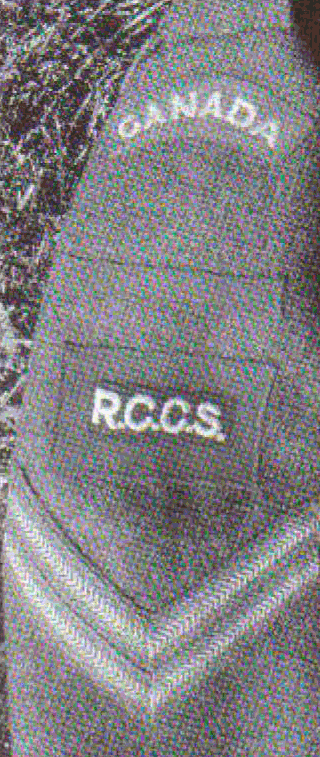
Battledress blouse of a corporal, Royal Canadian Corps of Signals, 1945. The buff-on-khaki 'CANADA' title appears above the red bar which sometimes indicated a division's second brigade, and the red rectangular patch of 1st Infantry Division. Corps were allowed to apply their titles to the divisional sign, in this case in white letters on dark blue. For details of the complex subject of Canadian sleeve insignia readers are recommended to consult Law, Clive, Distinguishing Patches - see Select Bibliography. (Ed Storey Collection)
As in all units, a lot of changes were soon made once in the field, especially to officers' gear and armament. The Sten guns were immediately found 'more dangerous to ourselves than to the Germans', and most officers laid them aside along with the bulky ammunition pouches. Instead they picked up .303in. rifles and disposable 50-round cotton bandoliers; Maj. (later Col.) Jacques Ostiguy recalled that 50 rounds was 'usually enough'. He wore his web waistbelt and hung grenades on it; his revolver was worn at the back, but he never used it - only the .303 'firing from the hip', which he had practised in England. On several occasions Germans armed with pistols shot at him, but always missed, while his rifle brought 'much better' results. He did not use the helmet much, finding it too heavy and awkward to wear. Instead he wore the beret, without the badge, or a woollen 'cap comforter'. On his shoulder straps Maj. Ostiguy wore his father's pips rather than 'the ones lined with red'. Later, when it got colder in Holland, Maj. Ostiguy preferred puttees to web anklets, for their warmth. (Recollections of Col. Ostiguy; Marchand, Gérard, Le Régiment de Maisonneuve vers la victoire 1944-45, Montréal: Presses Libres, 1980)
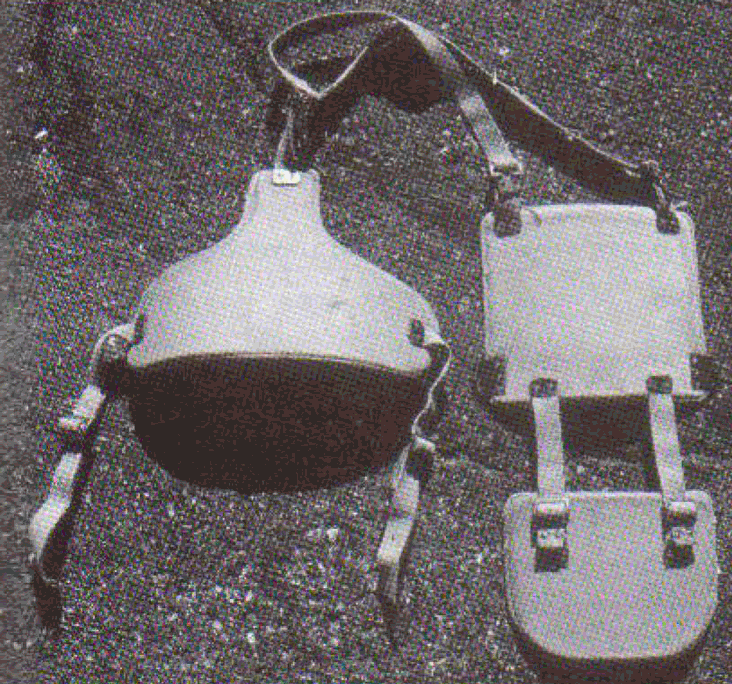
British 'MRC5 body armour was worn by some men of the 2nd and 3rd Inf Divs in 1944. This item originated from a Medical Research Council recommendation of 1940, but although issued in quantity for training it saw very little British use in action. However, some Royal Canadian Engineers with 3rd Inf Div wore it in Normandy; and the biggest users appear to have been infantrymen of 2nd Inf Div - soldiers of the Black Watch of Canada, South Saskatchewan Regt, Fusiliers Mont- Royal and Regt de Maisonneuve (see Plate E2) are known to have worn it. The back plate is at left, the two front plates at right, the lower one always worn low in order - recalled a Canadian Highlander - to protect 'the family jewels'; the steel plates were covered with tan fabric. The armour was only meant to give protection against low velocity projectiles and fragments; in the Maisonneuves, Maj. Ostiguy found that it did not stop rifle bullets. It was heavy and awkward and, after some of the men wearing it were killed anyway, it was abandoned as of doubtful value. (Ed Storey Collection)
E3: Private, Highland Light Infantry of Canada, 3rd Infantry Division; Normandy, June 1944
The Canadian infantry who secured Juno Beach on 6 June were basically dressed and equipped as this figure from the 9th Infantry Brigade. All had the new British Mk III helmet with net, BD, the buckle-flap boots soon nicknamed 'invasion' or '3rd Div' boots, and WE 37 accoutrements. The unit/national shoulder title is in yellow on a yellow-rimmed green backing; below it is the divisional patch, officially described as 'French grey' but found in several shades of light blue and blue-grey. Our man is well armed with a Sten gun Mk III and a PIAT (Projector, Infantry, Anti-Tank). Note that the 'universal pouches' of the 37 set could not be fastened when carrying Sten magazines. (Schipper, Paul, 'The 3rd Canadian Division on D-Day' Militaria Magazine, July 1995)
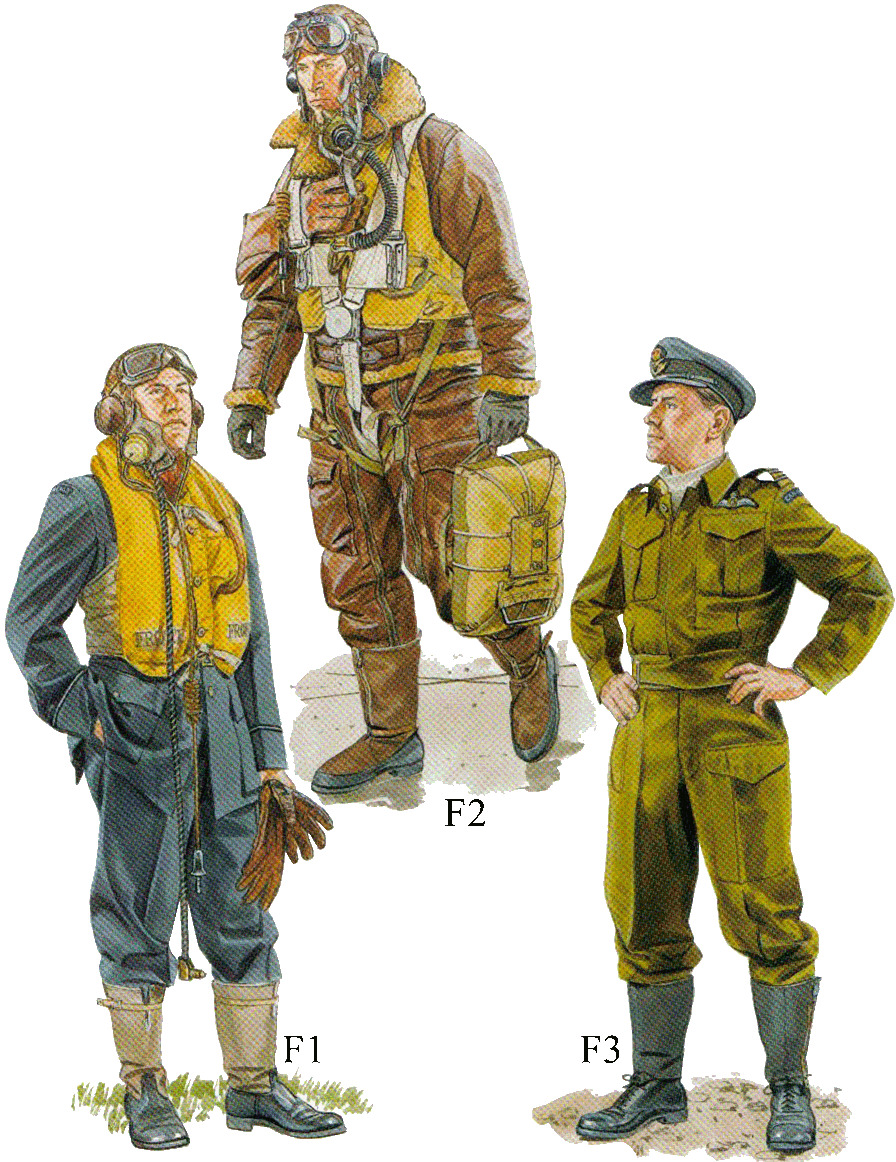
F1: Pilot Officer fighter pilot, RCAF; England, 1940-41
The pilot's service dress was similar to that worn by the RAF although increasingly made in Canada. The 'CANADA' shoulder title was worn only by RCAF personnel serving outside Canada. Our pilot wears the British 1939 pattern boots, 1933 gauntlet gloves, 1932 'Mae West' life jacket, and the Type B helmet with Mk III goggles. Note the single narrow cuff rank rings in light on dark blue.
F2: Air gunner, bomber crew, RCAF; England, 1942-44
The bomber crews of No.6 Group were issued the same heavy 'Irvin' sheepskin flying jacket and trousers as their RAF comrades. Our gunner wears 1941 pattern boots, gauntlet gloves, life jacket, helmet with Mk VII goggles and the 'Observer's' pattern parachute rig, all typical items for mid-war bomber crews.
F3: Flight Lieutenant fighter pilot, RCAF; NW Europe, late 1944
Following the stationing of fighter squadrons in France soon after the Normandy landings, it was feared that the blue-grey BD worn by RCAF personnel could be mistaken for German uniform, especially when dirty from use on front-line airstrips. From September, khaki BD was ordered worn instead when serving in NW Europe. The rank badges and other insignia were unchanged. This was not always greeted with joy, and some continued to wear the old blue-grey uniform; in November 1944, recalcitrant airmen of 83 Group were specifically ordered to get into the khaki Battledress. Our figure is a Typhoon pilot, wearing his service cap and 1943 pattern 'escape boots' with the khaki Battledress.
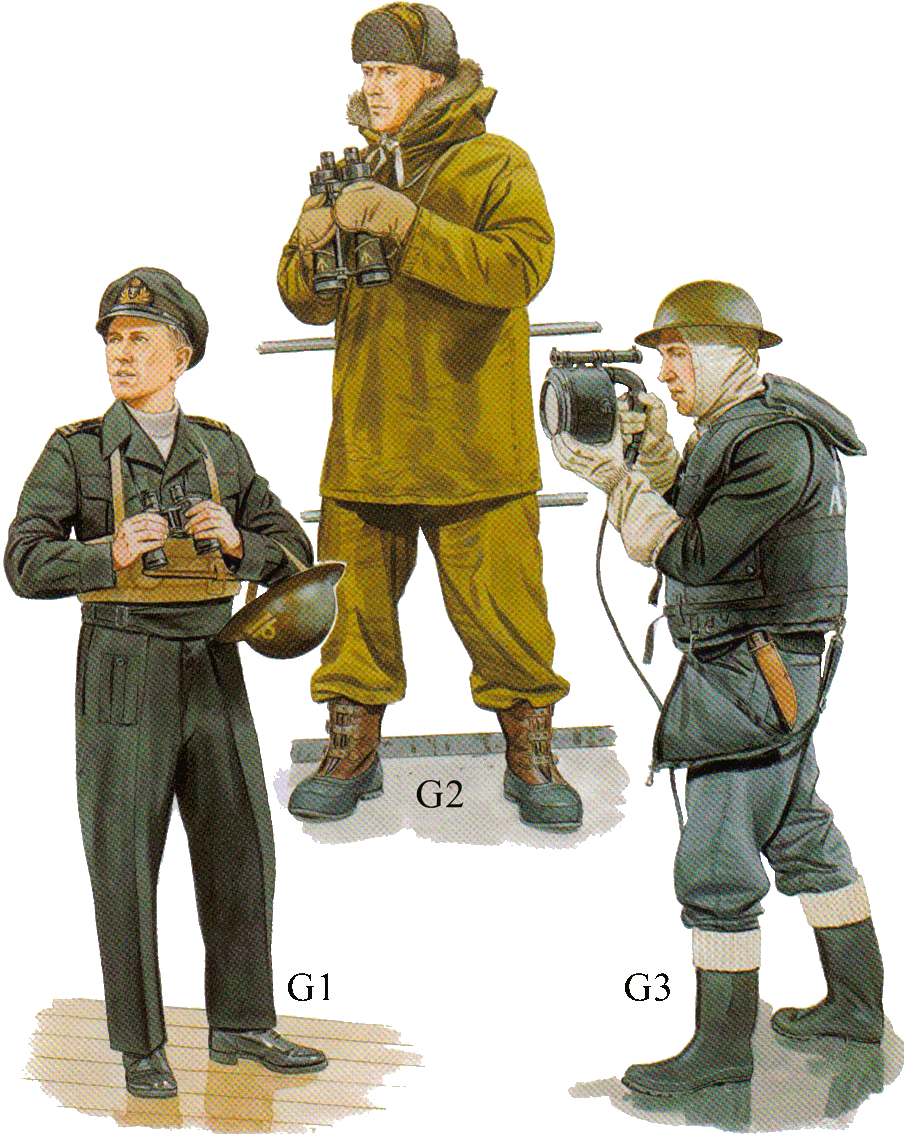
G1: Lieutenant, Royal Canadian Navy, 1941-45
From about 1941, many officers on the smaller ships such as corvettes took to wearing as working uniform the Army issue BD blouse dyed dark blue, or copies privately tailored from dark blue serge; rank was indicated on shoulder boards. Besides its advantages as a practical working dress, most officers were new to the service and often did not have the full service wardrobe of the Regular officers. Many veteran officers also liked BD, as it saved wear and tear on their more expensive service uniforms. In March 1942 the authorities acknowledged the fashion and officers were officially allowed to purchase at their own expense 'Blue Battledress serge uniforms consisting of blouse and trousers (Army Pattern)' for wear 'only while at sea'. Battledress was worn over the white turtleneck sweater when on watch in bad weather, and on more formal occasions with the white shirt and black tie. The officers' rank insignia were often painted on the front of the steel helmet worn when at 'action stations'. The rubber lifebelt was covered in white or khaki cotton, and fitted with a small inflation tube; it was worn around the waist over the uniform and secured with a neck tape, or carried in a small roll.
G2: Seaman, Royal Canadian Navy, Arctic convoys, 1941-45
Severe weather conditions were common in the North Atlantic, where most Canadian sailors served in small, wet warships. Foul weather gear included bulky dark blue-green oilskin raincoats with sou'wester hats and sea boots. The popular buff-coloured 'duffel' coat (named after the town of Duffel in Belgium, where this cloth was originally made) had a deep hood and fastened up the front with wooden toggles through cord loops; it was warm and comfortable in cold weather when worn with a scarf or towel at the neck, mittens and sea boots. Crews who sailed north of the Arctic Circle escorting convoys to Murmansk, Russia, faced the harshest conditions of all. They were issued this special winter clothing consisting of an outer parka and trousers of khaki waterproof Greenfell cloth, the parka hood being trimmed with wolf fur. A grey 'fearnaught' cloth parka was worn under the outer shell. Grey 'fearnaught' mittens with a trigger finger, and special winter boots, were also provided.
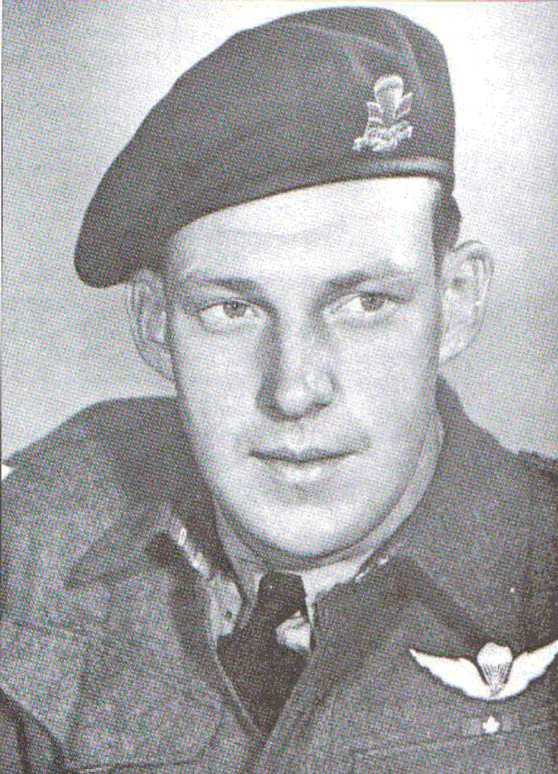
During Operation 'Varsity', the Rhine crossings in late March 1945, Cpl. Frederick G.Topham, a medical orderly with 1st Canadian Parachute Bn, won the Victoria Cross for rescuing wounded under fire. Note the silver cap badge of the unit; Canadian parachutist's 'wings' worn above the left pocket; and the battalion's gold identifying loop around his shoulder strap. See also Plate D3. (Private collection)
G3: Signals rating, Royal Canadian Navy, working dress, 1943-45
Besides the ratings' uniform jumpers and bell-bottom trousers, sailors spent much of their time wearing a practical on-board working dress consisting of a blue jean jacket, shirt and trousers. Only the rank and specialty badges were worn on this working dress, not the national title nor good conduct badges. The cap, rubber boots and a life jacket were often worn with this dress when on watch. At the beginning of the war the life jackets were large cork affairs covered with canvas, which were stowed in lockers and issued only in emergency.
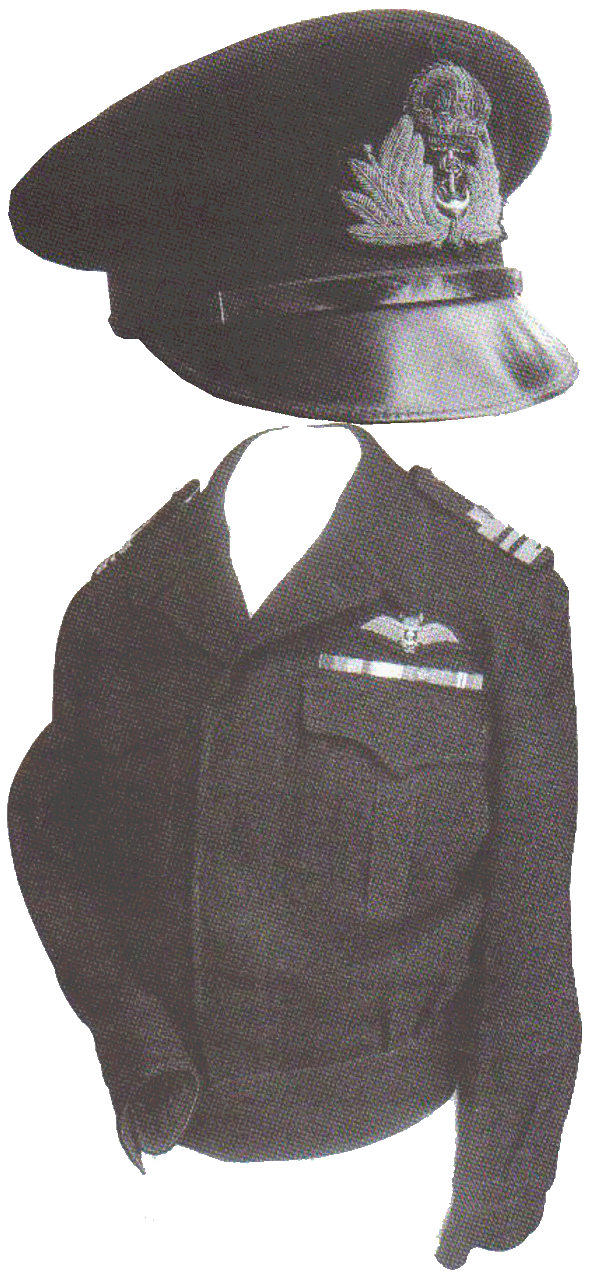
From about 1940 the less bulky inflatable life belt appeared, and was routinely worn or carried at all times when at sea - see G1. That very basic pattern was replaced from about 1943-44 by this aircrew-style vest with a collar to hold the head of an unconscious man up in the water; it was covered in dark blue fabric, with 'RCN' in large white letters and a smaller serial number stamped below. At 'action stations' most personnel wore the life jacket over the clothing, with a white fire-retardant flash hood, long matching gloves, and the khaki-painted Mk II steel helmet.
Royal Canadian Navy officer's cap, c1940-1945; and BD blouse of an RCN officer, c1945-46 - note that all buttons are concealed. This blouse shows lieutenant-commander's gold ranking on the shoulder boards, and on the breast the Fleet Air Arm wings. The gold, arc-shaped national shoulder title appears to have been added when a distinct Canadian naval air arm was formed at the end of the war. Cf Plate G1. (Ross M.A.Wilson Collection)
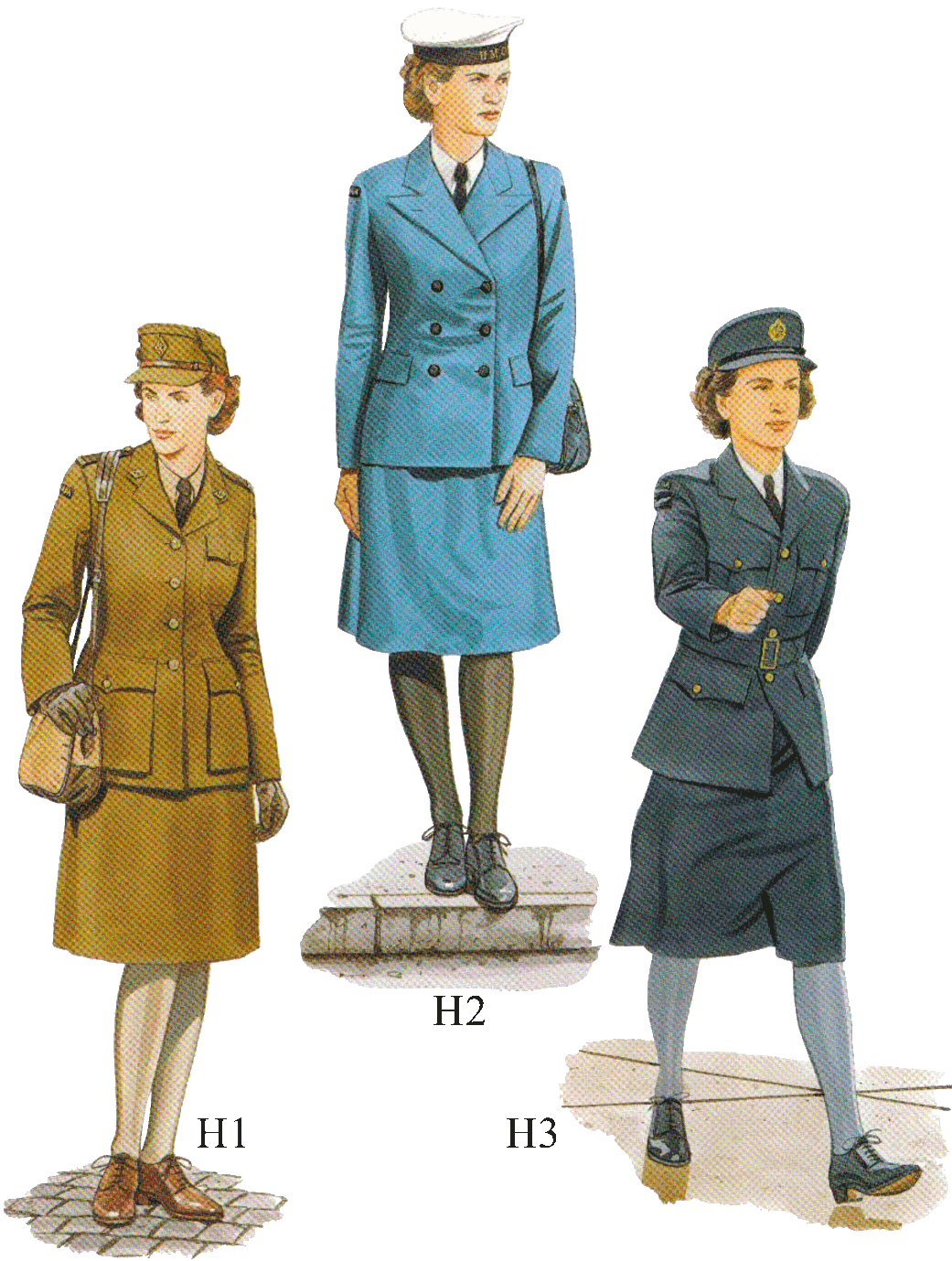
H1: Volunteer, Canadian Women's Army Corps; UK, 1942-45
Initially, in September 1941, the first volunteers continued wearing their volunteer groups' uniforms but with a cherry- red brassard bearing 'CWAC' in small white letters. (The 'cherry-red' shade is sometimes also described as beechnut-brown' - a dark reddish brown hue.) From 9 November the first uniforms started arriving individually addressed to each woman. Sergeant Ada Wilson (later Arney) recalled that the 'uniform, softly tailored in khaki, was an immediate hit with just about everyone. The official insignia was Athene, the Greek goddess of wisdom and protectress of cities and heroes of war'. The uniform consisted of a khaki tunic and skirt, the tunic having an open collar, two patch skirt pockets but only one left breast pocket, four buttons in front and the CWAC's distinctive red-brown shoulder straps; a light tan blouse with black tie, and a khaki cap (including the cloth visor). The brass cap badge was diamond-shaped with three maple leaves and the title of the corps; the brass collar badges and buttons had the helmeted head of Athene with 'C.W.A.C.' below; brass 'C.W.A.C.' titles were worn on the shoulder straps, and a white 'CANADA' title on a red-brown strip on the arms when serving outside Canada, later above a buff or yellow maple leaf and rim on a black disc. The summer uniform was similar but made of lightweight tan material. There were also tan raincoats, khaki double-breasted winter overcoats, brown laced shoes, work blouses, khaki trousers and laced work boots for some trades. (Arney, Ada, Here Come the Khaki Skirts: the Women Volunteers, Cobalt, Ontario; Highway Books, 1988)
H2: Rating, Women's Royal Canadian Naval Service, summer uniform, 1942-45
The service uniform of the WRCNS was similar to that of the British WRNS 'with the exception of the officer's skirts, which are gored rather than pleated'. However, the Canadian naval servicewomen had a distinct summer uniform, shown here. It was light blue with gilt buttons for officers and black buttons for other ranks. On this uniform officers' rank was marked by blue-black shoulder boards with gold lace stripes.
H3: Aircraftwoman, Royal Canadian Air Force Women's Division, 1942-45
The RCAF Women's Division ('Wids') wore the same air force blue-grey jacket and skirt as the British WAAFs, with a light blue-grey shirt and black tie, the same rank badges, and initially the same cap but with a cloth-covered visor. However, the second pattern cap was of this more becoming 'kepi' shape, with a higher stiffened front to the crown. Women serving outside Canada wore the RCAF national shoulder title.
We have much more interesting information on this site.
Click MENU to check it out!
∎ cartalana.com© 2009-2025 ∎ mailto: cartalana@cartalana.com